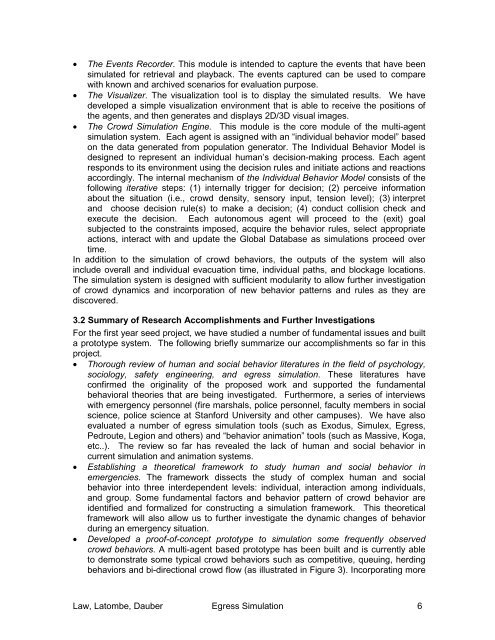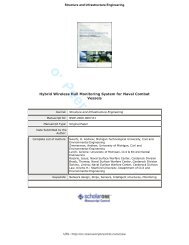Research Proposal - Engineering Informatics Group - Stanford ...
Research Proposal - Engineering Informatics Group - Stanford ...
Research Proposal - Engineering Informatics Group - Stanford ...
You also want an ePaper? Increase the reach of your titles
YUMPU automatically turns print PDFs into web optimized ePapers that Google loves.
• The Events Recorder. This module is intended to capture the events that have been<br />
simulated for retrieval and playback. The events captured can be used to compare<br />
with known and archived scenarios for evaluation purpose.<br />
• The Visualizer. The visualization tool is to display the simulated results. We have<br />
developed a simple visualization environment that is able to receive the positions of<br />
the agents, and then generates and displays 2D/3D visual images.<br />
• The Crowd Simulation Engine. This module is the core module of the multi-agent<br />
simulation system. Each agent is assigned with an “individual behavior model” based<br />
on the data generated from population generator. The Individual Behavior Model is<br />
designed to represent an individual human’s decision-making process. Each agent<br />
responds to its environment using the decision rules and initiate actions and reactions<br />
accordingly. The internal mechanism of the Individual Behavior Model consists of the<br />
following iterative steps: (1) internally trigger for decision; (2) perceive information<br />
about the situation (i.e., crowd density, sensory input, tension level); (3) interpret<br />
and choose decision rule(s) to make a decision; (4) conduct collision check and<br />
execute the decision. Each autonomous agent will proceed to the (exit) goal<br />
subjected to the constraints imposed, acquire the behavior rules, select appropriate<br />
actions, interact with and update the Global Database as simulations proceed over<br />
time.<br />
In addition to the simulation of crowd behaviors, the outputs of the system will also<br />
include overall and individual evacuation time, individual paths, and blockage locations.<br />
The simulation system is designed with sufficient modularity to allow further investigation<br />
of crowd dynamics and incorporation of new behavior patterns and rules as they are<br />
discovered.<br />
3.2 Summary of <strong>Research</strong> Accomplishments and Further Investigations<br />
For the first year seed project, we have studied a number of fundamental issues and built<br />
a prototype system. The following briefly summarize our accomplishments so far in this<br />
project.<br />
• Thorough review of human and social behavior literatures in the field of psychology,<br />
sociology, safety engineering, and egress simulation. These literatures have<br />
confirmed the originality of the proposed work and supported the fundamental<br />
behavioral theories that are being investigated. Furthermore, a series of interviews<br />
with emergency personnel (fire marshals, police personnel, faculty members in social<br />
science, police science at <strong>Stanford</strong> University and other campuses). We have also<br />
evaluated a number of egress simulation tools (such as Exodus, Simulex, Egress,<br />
Pedroute, Legion and others) and “behavior animation” tools (such as Massive, Koga,<br />
etc..). The review so far has revealed the lack of human and social behavior in<br />
current simulation and animation systems.<br />
• Establishing a theoretical framework to study human and social behavior in<br />
emergencies. The framework dissects the study of complex human and social<br />
behavior into three interdependent levels: individual, interaction among individuals,<br />
and group. Some fundamental factors and behavior pattern of crowd behavior are<br />
identified and formalized for constructing a simulation framework. This theoretical<br />
framework will also allow us to further investigate the dynamic changes of behavior<br />
during an emergency situation.<br />
• Developed a proof-of-concept prototype to simulation some frequently observed<br />
crowd behaviors. A multi-agent based prototype has been built and is currently able<br />
to demonstrate some typical crowd behaviors such as competitive, queuing, herding<br />
behaviors and bi-directional crowd flow (as illustrated in Figure 3). Incorporating more<br />
Law, Latombe, Dauber Egress Simulation 6






